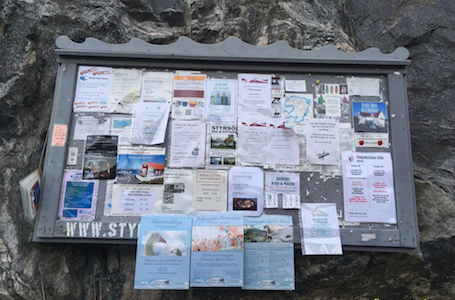- Home
- News and events
- Find news
- Analog bulletin boards still popular
Analog bulletin boards still popular
 They can be seen every day: outside supermarkets, inside libraries and in the workplace lunchroom. Analog bulletin boards are abundant throughout the urban landscape. But in an era of social media and digital technologies, one might wonder, are paper messages attached to a cork board still used for communication? A team of Swedish researchers have conducted the world’s largest study of analog bulletin board messages, and they conclude that it is still alive and kicking!
They can be seen every day: outside supermarkets, inside libraries and in the workplace lunchroom. Analog bulletin boards are abundant throughout the urban landscape. But in an era of social media and digital technologies, one might wonder, are paper messages attached to a cork board still used for communication? A team of Swedish researchers have conducted the world’s largest study of analog bulletin board messages, and they conclude that it is still alive and kicking!
– Instead of being replaced by new media technologies, analog bulletin board messages have adapted to the new media landscape by for example including references to Facebook groups, Instagram accounts, e-mail addresses and web sites, says Christopher Kullenberg, Associate Professor in Theory of Science at the University of Gothenburg.
The study, published in Plos One, has been conducted by twelve researchers at the universities of Gothenburg, Stockholm, Örebro and Southern Denmark. With the aid of almost one hundred school classes, the research group has collected bulletin board messages from all around Sweden. The results show that the boards are widely used for multiple categories of messages, ranging from buy- and sell ads to invitations to concerts and local events.
– Bulletin boards work particularly well for communicating very local events, for example a football game or a missing pet. Because they are constrained by their physical whereabouts, we might call it a hyper-local medium. This makes bulletin boards particularly good at reaching site-specific audiences, for example a neighborhood or a village, says Sara Van Meerbergen, Senior Lecturer in Dutch at Stockholm University.
– This is the largest study of bulletin boards yet conducted. We have analyzed more than a thousand messages across Sweden and then analyzed in detail the categories of messages, how they are made and which other media technologies they make use of, says Johan Järlehed, Associate Professor in Spanish at the University of Gothenburg. The most common user of a bulletin board is a civil society association, such as a sports club, a study group or a religious congregation, who are the senders of more than 40 per cent of the messages. Companies, selling both goods and services, comprise around 30 per cent of the messages, and private persons make up 14 per cent of the average bulletin board content.
In order to collect and classify bulletin board messages from around Sweden the research group invited school children to help them out.
 – The method is called citizen science, a research design in which scientists are aided by the general public, in our case teachers and school children. Without the help of the school classes we would never have been able to collect so many messages from such a vast geographical area, says Christopher Kullenberg (photo).
– The method is called citizen science, a research design in which scientists are aided by the general public, in our case teachers and school children. Without the help of the school classes we would never have been able to collect so many messages from such a vast geographical area, says Christopher Kullenberg (photo).
The article, What are analog bulletin boards used for today? Analysing media uses, intermediality and technology affordances in Swedish bulletin board messages using a citizen science approach, is published in the open access journal Plos One https://doi.org/10.1371/journal.pone.0202077.
The project was carried out in collaboration with the non-profit organization VA (Public & Science), as part of ForskarFredag – the Swedish events on the European Researchers’ Night.
The study was funded by the Marianne and Marcus Wallenberg foundation and the European Union’s Horizon 2020 research and innovation programme. It was awarded the Open Knowledge Award’s price for Best Open Science during the year of data collection in 2016.
(http://okawards.org/winners-2016/)
Contact:
Christopher Kullenberg, University of Gothenburg, christopher.kullenberg@gu.se, +46 (0)735083022
Sara Van Meerbergen, Stockholms University, sara.vanmeerbergen@su.se, +46 (0)8-163303
Johan Järlehed, University of Gothenburg, johan.jarlehed@sprak.gu.se, +46 (0)31-7861777
 Photo: Monica Havström, University of Gothenburg
Photo: Monica Havström, University of Gothenburg
Bulletin board at Styrsö, Gothenburg